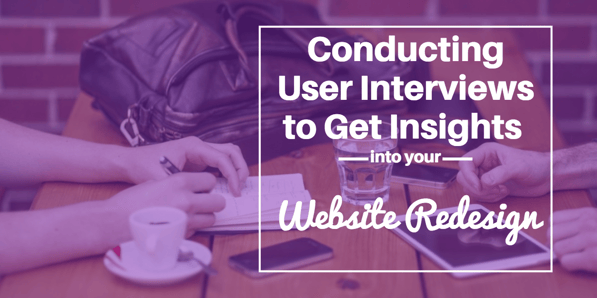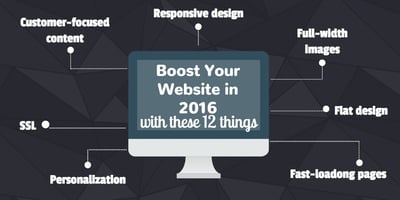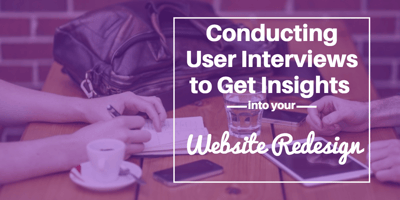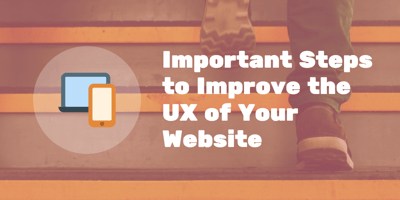
We’ve already discussed the importance of a great user experience on your website and a few ways to help implement that on your website. But one important step to achieving great UX is understanding your website users.
This is where user research comes in.
User research is imperative in the beginning stages of your website redesign. The better you understand (not just assume you understand) your users, the more success you’ll see on your website. With this insight, you can create a website with less friction and higher conversion.
There are several different types of user research like interviews, surveys, and usability testing. Let’s discuss how to conduct user surveys to give you better insights into UX and web redesign.
Determine your goals
Before you dive into the interviews, determine which questions you need answered or problems you want to solve for your website design: What is your company mission? What is the value proposition? Who are your buyer personas? What pain points are your personas trying to fix? Once you’ve determined the answers, you should have some good goals set.
Grab a team member to sit in on the interviews with you. You can take turns talking and taking notes. This helps capture information that may slip past just one person. Two to three people can give more perspective on an interview than just one.
Finding people to interview for website user research
Next, you want to talk to your website users. Reach out to a variety of people in and outside your organization.
When selecting interviewees, let them know the purpose behind the interview. Tell them why they’re invited to participate. If you notify them before the interview, you can optimize your time in the actual interview.
Talk to people in and out of your organization—employees, customers, and prospects.
- Employees at your company: Choose people who deal with customers or prospects directly. You want someone who has a good understanding of how users interact with your company and your website.
- Customers: Reach out to customers who took part in the process to choose your company for business. This will give you a lot more insight into their buying journey and how you won them over.
- Prospects: Look for prospects that meet your buyer personas to discover more about how they gather information, what they value, etc.
User interview timeline
Interviews should be around half an hour. In the first few minutes, talk with the user about their role in their company and gather other information about their demographics and background. After the initial welcome portion of the interview, spend about 20-25 minutes getting into the meat of the discussion. Wrap up the interview after about 25-30 minutes. Ask if there’s anything else they want to share and follow up on any questions you have from your notes.
Conducting user interviews
User interviews should be conversational. Make an interview outline or jot down a list of questions you would like to ask, but don’t be rigid about sticking to your notes. Let the interviewee do most of the talking, you just get the conversation rolling.
Try not to prime for a specific answer. Keep questions open-ended so you can get as much information as possible and to help show your interviewee there is no right or wrong answer. And always be a good listener!
What kind of questions to ask in user interviews
Ask questions that help confirm or debunk any assumptions you may have had about the website and its users.
Here’s where you want to ask some questions about how they interact with your company and website.
Some question you ask may include:
- How often do you use the website?
- For what purpose do you use the website?
- The last time you used the website, what was your objective?
- What’s your favorite aspect or most used tool from the website?
- Are there any obstacles keeping you from getting more out of the website or the company?
- What do you do when you have a problem with a product/service?
- Where could the website improve?
Remember to observe and engage without influencing the users or making assumptions about them. Make notes about what they actually say, don’t assume what they meant by a statement. Follow up on everything. This is a great way to avoid misinterpretations. Dig a little deeper to find out what they really mean rather than thinking you already understand. You want to learn how this user perceives the world around him or her to understand how they will perceive your company and website too.
Once you’ve completed the interview, debrief it with your team member. Identify patterns and insights. Which themes do you see from the responses? Start with five to ten interviews to begin to identify patterns, and evaluate if you will need any additional interviews after that.
Good user research is a foundational step in the website redesign process. Using qualitative and quantitative data, you can design a website that delights your users and meets their goals (and your company’s goals too). Other user research may include user surveys, heat maps, scroll maps, and more.
Next steps
Once you’ve completed the user research phase in your website redesign, you can move into user testing including user recordings and A/B testing.
Learn more about the phases of a successful website redesign that keeps working for you. Get your free ebook on the strategy that’s changing the way we look at websites.






